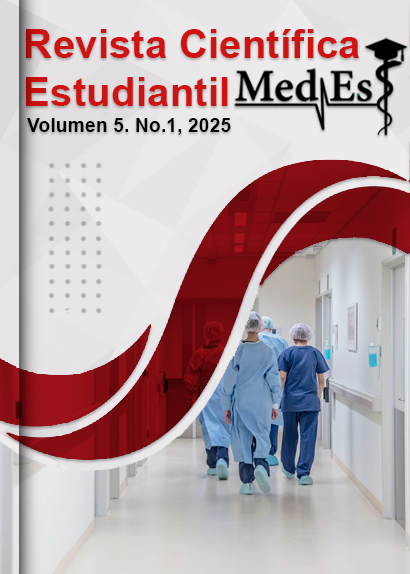Surgical approach and rehabilitation in ARCAPA syndrome: report of a pediatric case
Keywords:
Arteria Pulmonar, Congenital Heart Disease, Cardiac Surgical Procedures, Cardiac Rehabilitation, Pulmonary ArteryAbstract
Introduction: anomalous origin of the right coronary artery from the pulmonary artery (ARCAPA syndrome) is an extremely rare congenital malformation, with an estimated prevalence of 0.002% among all congenital heart defects. This condition is characterized by an anomalous origin of the right coronary artery from the pulmonary trunk, resulting in reverse coronary flow, risk of myocardial ischemia, and life-threatening complications, especially in the pediatric population.
Objective: to describe the case of a pediatric patient diagnosed with ARCAPA syndrome.
Case presentation: a 15-year-old male adolescent with no significant medical history presented with fatigue, anginal-like chest pain, and dyspnea on exertion. Physical examination revealed muffled heart sounds and asynchronous peripheral pulses. The electrocardiogram showed changes suggestive of ischemia, and cardiac magnetic resonance imaging confirmed the anomalous origin of the right coronary artery from the pulmonary artery with retrograde flow. Surgical correction was performed with an end-to-side anastomosis to the ascending aorta, followed by a cardiac rehabilitation program. The outcome was favorable, with complete restoration of cardiovascular function.
Conclusions: this condition is a potential cause of sudden death in young patients and should be included in the differential diagnosis of chest pain and exertional dyspnea. Accurate detection requires Doppler echocardiography and cardiac magnetic resonance imaging. Treatment with early surgical anastomosis restores coronary flow, complemented by cardiac rehabilitation. Multidisciplinary management involving cardiologists, surgeons, and rehabilitation specialists is essential for the therapeutic success of this complex congenital anomaly.
Downloads
References
1. Franco A, Cadenasso B, Antúnez S, Anzíbar R, Touyá G. Origen anómalo de la arteria coronaria derecha desde el tronco de la arteria pulmonar (ARCAPA). Arch. Pediatr. Urug. [Internet]. 2018 [citado 10/06/2025]; 89(2): 108-112. Disponible en: http://www.scielo.edu.uy/scielo.php?script=sci_arttext&pid=S1688-12492018000200108&lng=es.
2. Kolesár A, Toporcer T, Čobejová J, Lukačin Š. Anomalous Arising of Right Coronary Artery from the Pulmonary Artery. Journal of Cardiovascular Development and Disease [Internet]. 2024 [citado 10/06/2025]; 11(2): 50. Disponible en: https://doi.org/10.3390/jcdd11020050
3. Arqué Gibernau JM, Arias Recalde A, Bravo Marqués R. Síndrome de ARCAPA en la edad adulta. Rev Esp Cardiol [Internet]. 2017 [citado 10/06/2025]; 70(8): 665. Disponible en: https://www.revespcardiol.org/es-sindrome-arcapa-edad-adulta-articulo-S0300893216304390
4. Suchodolski A, Galeczka M, Szulik, Fiszer R, Glowacki J. Anomalous origin of the right coronary artery originating from the pulmonary trunk: pre-and postoperative computed tomography images and virtual reality reconstructions. Coronary Artery Disease [Internet]. 2024 [citado 10/06/2025]; 35(2): 164 - 165. Disponible en: https://doi.org/10.1097/MCA.0000000000001315
5. Karila-Cohen J, Laux D, Houyel L, Bonnet D. Aorta without coronary arteries: anatomic variants of a rare malformation. Pediatric Cardiology [Internet]. 2024 [citado 10/06/2025]; 45(1): 200 - 207. Disponible en: https://doi.org/10.1007/s00246-023-03330-7
6. Landi I, Alkhabaz A, Abou Shaar B, Galzerano D, Albert-Brotons D, Tahir M, et al. Non-atherosclerotic coronary artery disease: an overview of a heterogeneous disease. Coronary Artery Disease [Internet]. 2024 [citado 10/06/2025]; 10: 1097. Disponible en: https://doi.org/10.1097/MCA.0000000000001317
7. Song Y, Choi ES, Kim DH, Kwon BS, Park CS, Yun TJ. Surgical Managements of Coronary Artery Fistulas in Children.Journal of Chest Surgery [Internet]. 2024 [citado 10/06/2025]; 57(1): 79. Disponible en: https://doi.org/10.5090/jcs.23.101
8. Giamberti A, Chessa M, Evangelista M, Caldaroni F. Anomalous origin of the Coronary Arteries from the Pulmonary Artery: ALCAPA and ARCAPA. Congenital Anomalies of Coronary Arteries [Internet]. 2023 [citado 10/06/2025]; 75 - 83. Disponible en: https://doi.org/10.1007/978-3-031-36966-7_7
9. Castro CR, Fachado F. Síndroma ARCAPA: o papel do médico de familia na gestão de uma doença rara. Revista Portuguesa de Meicina Geral e Familiar [Internet]. 2023 [citado 10/06/2025]; 39(1): 67 - 72. Disponible en: https://doi.org/10.32385/rpmgf.v39i1.13470
10. González Hoyos D, López Arroyave M, Sebastián Quiñones J, Abad Díaz P, Carvajal Vélez M. Anomalías de las arterias coronarias: una revisión de la literatura y propuesta de una nueva clasificación. Revista Colombiana de Cardiología. [Internet] 2023 [citado 10/06/2025]; 30(6): 390 – 402. Disponible en: http://scielo.org.co/scielo.php?script=sci_arttext&pid=S0120-56332023000600390&Ing=en
11. Fernández Cordón C, Prieto Arévalo R, Bermejo J, Fernández Avilés F. Actualización en cardiopatías congénitas del adulto. Medicine-Programa de Formación Médica Continuada creditado. [Internet] 2021 [citado 10/06/2025]; 13(41): 2379 – 2389. Disponible en: https://sciencedirect.com/science/article/pii/S0304541221002353
12. Faz Pujalte M, Richart Martínez M, Perpiñá Galván J. Análisis de la efectiviad de la rehabilitación cardiaca en España: una revisión istematica exploratoria. Anales del Sistema Sanitario de Navarra [Internet] 2022 [citado 10/06/2025]; 45(1). Disponible en: http://scielo.isciii.es/scielo.php?script=sci_arttext&pid=S1137-66272022000100011&Ing=en
13. Khajali Z, Zangenehfar ME, Maadani M, Parsaee M. A Young Woman with Atypical Chest Pain: Introducing a rare Case of ARCAPA. Multidisciplinary Cardiovascular Annals [Internet]. 2024 [citado 10/06/2025]; 11(2). Disponible en: https://doi.org/10.51812/mca.106461
Downloads
Published
How to Cite
Issue
Section
License
Copyright (c) 2025 Miguel Enrique Barroso-Fontanals, Karla María Ascanio-Cruz , Carlos Roberto Urgelles-Oliva , Malena Laura Vázquez-Núñez

This work is licensed under a Creative Commons Attribution-NonCommercial 4.0 International License.
Those authors who have publications with this journal accept the following terms: The authors will retain their copyright and guarantee the journal the right of first publication of their work, which will be simultaneously subject to the Recognition License. Creative Commons that allows third parties to share the work as long as its author and its first publication in this magazine are indicated. Authors may adopt other non-exclusive license agreements for the distribution of the published version of the work (e.g.: deposit it in an institutional telematic archive or publish it in a monographic volume) as long as the initial publication in this journal is indicated. Authors are allowed and recommended to disseminate their work through the Internet (e.g.: in institutional telematic archives or on your website) before and during the submission process, which can produce interesting exchanges and increase citations of the published work.





